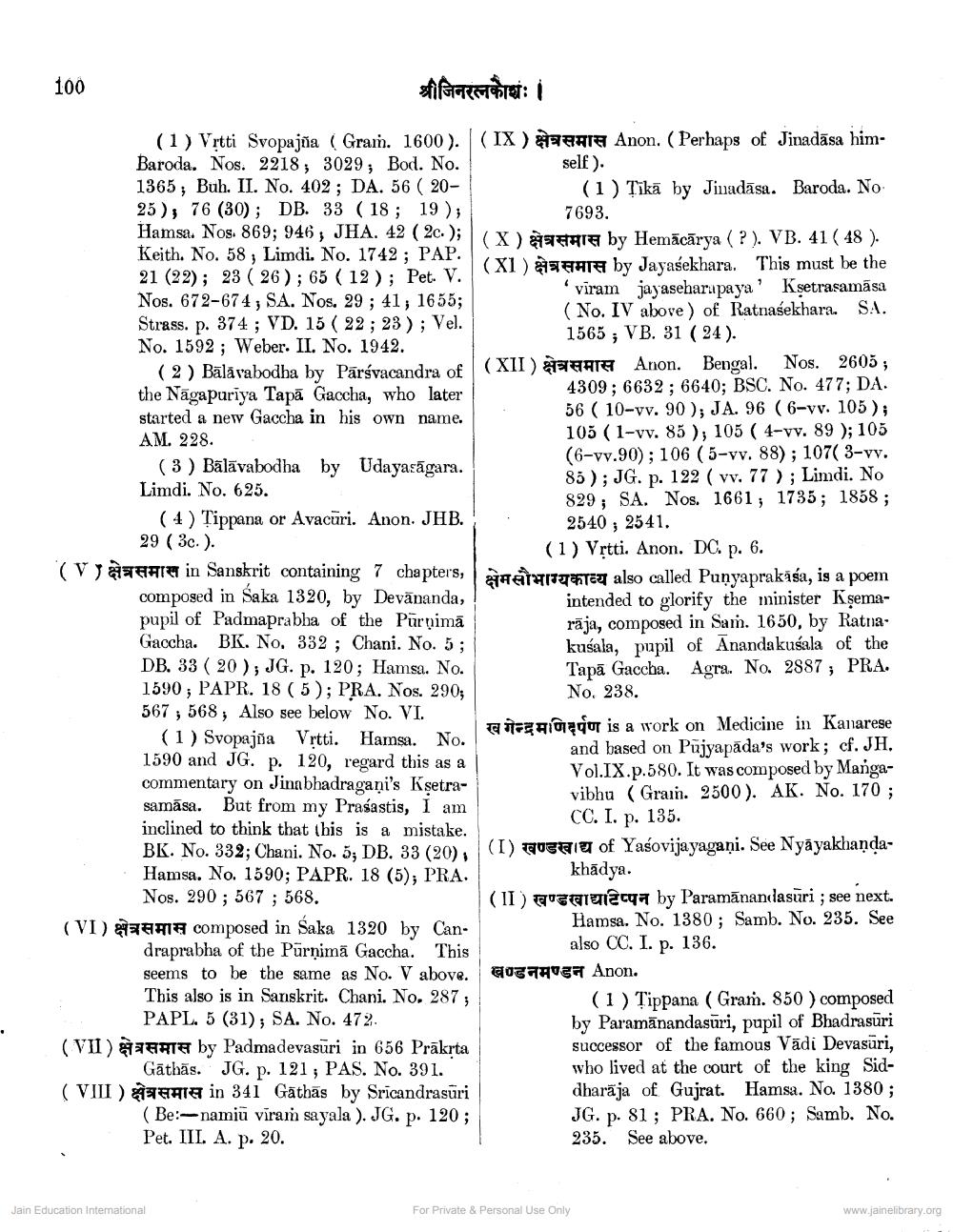________________
100
श्रीजिनरलकाः ।
The
?); Peter
(1) Vrtti Svopajña (Grai. 1600). (IX) FAAIT Anon. (Perhaps of Jinadāsa himBaroda. Nos. 2218; 3029; Bod. No.
self). 1365, Buh. II. No. 402; DA. 56 ( 20
(1) Tīkā by Jinadāsa. Baroda. No 25), 76 (30); DB. 33 (18; 19 );
7693. Hamsa. Nos. 869; 946, JHA. 42 ( 2c.);
IELATE by Hemācārya (?). VB. 41( 48 ). Keith. No. 58, Limdi. No. 1742; PAP.
(XI) FATE by Jayasekhara. This must be the 21 (22); 23 (26); 65 (12); Pet. V.
viram jayaseharupaya' Ksetrasamāsa Nos. 672-674, SA. Nos. 29; 41; 1655;
(No. IV above) of Ratnasekhara. SA. Strass. p. 374 ; VD. 15 ( 22; 23 ); Vel.
1565 ; VB. 31 (24). No. 1592; Weber. II. No. 1942.
(2) Bälävabodba by Pārsvacandra of (XII) SEATE Anon. Bengal. Nos. 2605; the Nagapuriya Tapā Gaccha, who later
4309; 6632 ; 6640; BSC. No. 477; DA. started a new Gaccha in his own name.
56 ( 10-vv. 90 ); JA. 96 (6-vy. 105); AM. 228.
105 (1-vv. 85 ); 105 ( 4-vv. 89 ); 105 (3) Bālāvabodha by Udayasāgara.
(6-vv.90); 106 ( 5-vv. 88); 107( 3-vv.
85); JG. p. 122 (vv. 77 ); Limdi. No Limdi. No. 625.
829; SA. Nos. 1661; 1735; 1858 ; (4) Tippana or Avacuri. Anon. JHB.
2540 ; 2541, 29 ( 3c.).
(1) Vrtti. Anon. DC. p. 6. (Vyamar in Sanskrit containing 7 chapters, ATTITUTE also called Punyaprakāśa, is a poem composed in Saka 1320, by Devänanda,
intended to glorify the minister Kşemapupil of Padmaprabha of the Purnimā
räja, composed in Sam. 1650, by Ratna. Gaccha. BK. No. 332 ; Chani. No. 5;
kusala, pupil of Anandakusala of the DB. 33 ( 20 ); JG. p. 120; Hamsa. No.
Tapā Gaccha. Agra. No. 2887; PRA. 1590; PAPR. 18 (5); PRA. Nos. 290;
No. 238. 567 ; 568; Also see below No. VI.
| खगेन्द्रमणिदर्पण is a work on Medicine in Kanarese (1) Svopajña Vrtti. Hamsa. No. 1590 and JG. p. 120, regard this as a
and based on Pujyapāda's work; cf. JH.
Vol.IX.p.580. It was composed by Mangacommentary on Jinabhadragani's Kşetra
vibhu (Grain. 2500). AK. No. 170 ; samāsa. But from my Prasastis, I am inclined to think that this is a mistake.
CC. I. p. 135. BK. No. 332; Chani. No. 5; DB. 33 (20)
(I) Tead of Yasovijayagani. See NyayakhandaHamsa. No. 1590; PAPR. 18 (5); PRA.
khādya. Nos. 290 ; 567 ; 568.
(II) EVEWIVqa by Paramānandasuri ; see next. (VI) IAR composed in Saka 1320 by Can
Hamsa. No. 1380; Samb. No. 235. See draprabha of the Pūrnimā Gaccha. This
also CC. I. p. 136. seems to be the same as No. V above. This also is in Sanskrit. Chani. No. 287;
(1) Tippana (Gram. 850 ) composed PAPL. 5 (31); SA. No. 472
by Paramānandasuri, pupil of Bhadrasuri (VII) TARTE by Padmadevasuri in 656 Prākrta
successor of the famous Vädi Devasüri, Gātās. JG. p. 121 ; PAS. No. 391.
who lived at the court of the king Sid(VIII) TEHTA in 341 Gāthās by Sricandrasuri
dharaja of Gujrat. Hamsa. No. 1380; ( Be:--namiū viram sayala ). JG. p. 120 ;
JG. p. 81 ; PRA. No. 660 ; Samb. No. Pet. III. A. p. 20.
235. See above.
90374489 Anon
Jain Education Intemational
For Private & Personal Use Only
www.jainelibrary.org




